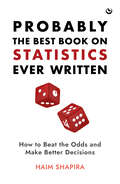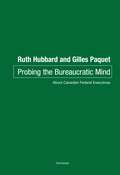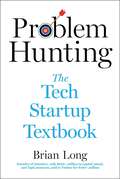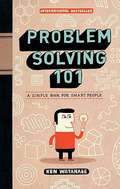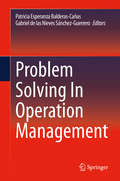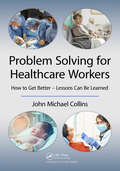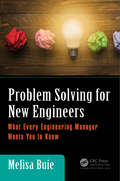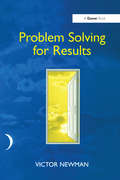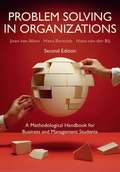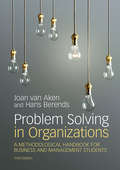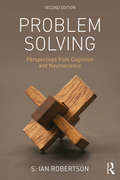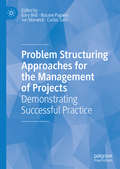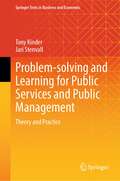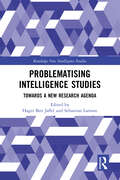- Table View
- List View
Probably the Best Book on Statistics Ever Written: How to Beat the Odds and Make Better Decisions
by Haim ShapiraTaking an amusing and digestible look at the usually dry world of probability and statistics, this is the ultimate guide to how you can incorporate them into everyday life, from one of the world's most sought-after experts in game theory. This is the only book you need to become a statistics whizz! Numbers are everywhere – food packaging, weather forecasts, social media, adverts, and more. You can&’t escape them. But you can learn to understand them – and avoid being fooled! This book breaks down the key fundamentals in statistics in a fun and accessible way so that you can understand the numbers that occupy your life. • Make sense of sports stats – discover who is the greatest scorer of all time • Learn to interpret scientific studies and how they&’re reported in the media so you&’re never misled again • Discover tips and tricks to make you a more successful gambler • Explore what role stats has to play in flat-earth conspiracy arguments • Read about misunderstood probabilities in the Sally Clarke and OJ Simpson trials With easy-to-follow explanations, tables, graphs, and real-life examples, this book helps you evaluate your options, calculate your chances of success, and make better decisions.
Probate
by Gordon BowleyThe majority of applications for probate that follow someone's death can be dealt with inexpensively by any reasonably intelligent person with time available and a little guidance. This easy-to-follow book clearly explains all the information you need to administer the deceased's estate; from dealing with the urgent practical matters to preparing and submitting the relevant forms, paying inheritance tax, and distributing the estate. You'll find specimen forms and letters and a list of useful addresses that will enable you to deal with it all yourself.
Probate Wars of the Rich and Famous: An Insider's Guide to Estate Planning and Probate Litigation
by Russell J. FishkindSurrogate Court dockets are filled with cases involving family members fighting over the assets and intentions of a deceased parent or spouse. Probate Wars of the Rich & Famous: An Insider’s Guide to Estate Planning and Probate Litigation tracks the estate litigation cases of Anna Nicole Smith, Brooke Astor, Michael Jackson, Nina Wang, Jerry Garcia and Leona Helmsley and identifies the five universal factors that caused such disputes. Each chapter provides estate planning insights designed to help individuals plan their estates without causing litigation. If, however, probate litigation cannot be avoided, the book also provides invaluable lessons about undue influence claims, how to remove a fiduciary, demanding an estate accounting and claims seeking to set aside lifetime transfers that undermined the decedents intentions. Few - if any – estate planning books utilize colorful celebrity accounts to provide meaningful insights and actionable advice.
Probate: A Self-help Guide
by Gordon BowleyThe majority of applications for probate that follow someone's death can be dealt with inexpensively by any reasonably intelligent person with time available and a little guidance. This easy-to-follow book clearly explains all the information you need to administer the deceased's estate; from dealing with the urgent practical matters to preparing and submitting the relevant forms, paying inheritance tax, and distributing the estate. You'll find specimen forms and letters and a list of useful addresses that will enable you to deal with it all yourself.
Probing the Bureaucratic Mind: About Canadian Federal Executives
by Gilles Paquet Ruth HubbardThis book explores the thinking of Canadian federal public service senior executives through conversations. The transformation of the environment and of the institutional order has created quite a challenge: maintaining some sort of adequacy between these evolving realities and the frames of reference in use by public sector executives. Complexity is often nothing more than a name for a new order calling for a new frame of reference, and the reluctance to abandon old conceptual frameworks is often responsible for fundamental learning disabilities. Through a series of conversations with Canadian federal senior executives about more and more daunting problems - from coping with an evolving context, to engaging intelligently with a new modus operandi, to trying to nudge and tweak programs in order to correct toxic pathologies, to reframing perceptions and redesigning organizations to meet the new challenges—weaknesses of the capabilities of the Canadian federal executives to respond to current challenges were revealed, and suggestions made about ways to kick start a process of refurbishment of these capabilities.
Problem Hunting: The Tech Startup Textbook
by Brian LongA unicorn founder gives step-by-step advice on everything from finding product-market fit to managing investors In Problem Hunting: The Tech Startup Textbook, Brian Long offers a tactical approach to building a tech company based on his experience growing a multi-billion dollar software business and selling another business to Twitter for nine figures. This is a daily playbook that any budding entrepreneur will return to over and over again as a reference when building their business.Problem Hunting is broken down into chapters giving simple, step-by-step advice for each stage and functional department needed to run a startup tech company: Finding and testing product market fit Creating and refining your product Selling and marketing your new solution Hiring your team and building your culture Mobilizing financial, legal, and compliance functions Pitching investors and securing funding Built upon learning and anecdotes from a unicorn founder, Problem Hunting has everything prospective entrepreneurs and leaders need to start their business.
Problem Solver: Maximizing Your Strengths to Make Better Decisions (AREA Method Publications)
by Cheryl Strauss EinhornOur decisions are expressions of who we are and how we move through the world. Rarely, though, do we examine our decisions or even look inward to consider the psychology of our decision-making. Instead, we often make decisions based on what we call instinct (which relies on cognitive bias), false assumptions, mis-remembering, and mental mistakes. Truthfully, we don't see the world as it is; we see it as we are. We can develop self-knowledge about our decision-making styles. We can wake ourselves up to how biases cloud our judgment and impede good decision-making—and we can counter bias. From there, we can transform our decision-making habits to make better big decisions alone and together. Problem Solver provides you with tools to identify:• The five basic decision-making approaches, or "Problem Solver Profiles" (PSPs): Adventurer, Detective, Listener, Thinker, and Visionary • Your dominant—and secondary—PSPs• Tools to assess other peoples' PSPs• Each PSP's decision-making strengths, blind spots, and biases• How your PSP impacts your outlook on life and your risk appetite• How to use your PSP to maximize your decision strengths Replete with real-life examples and replicable strategies to apply new decision-making skills for your immediate benefit, Problem Solver will do more than help you look out into a future; it will equip you to move forward, with confidence, into your future.
Problem Solving 101: A Simple Book for Smart People
by Ken WatanabeThe fun and simple problem-solving guide that took Japan by stormKen Watanabe originally wrote Problem Solving 101 for Japanese schoolchildren. <P><P>His goal was to help shift the focus in Japanese education from memorization to critical thinking, by adapting some of the techniques he had learned as an elite McKinsey consultant. He was amazed to discover that adults were hungry for his fun and easy guide to problem solving and decision making. The book became a surprise Japanese bestseller, with more than 370,000 in print after six months. Now American businesspeople can also use it to master some powerful skills. Watanabe uses sample scenarios to illustrate his techniques, which include logic trees and matrixes. A rock band figures out how to drive up concert attendance. An aspiring animator budgets for a new computer purchase. Students decide which high school they will attend. Illustrated with diagrams and quirky drawings, the book is simple enough for a middleschooler to understand but sophisticated enough for business leaders to apply to their most challenging problems.
Problem Solving For Results
by William RothTurbulence is not new to the business world. In fact, the turbulence is increasing and managers are seeing teams spinning their wheels. But now there is a book that addresses these realities-Problem Solving for Results.Management systems are in a state of crisis and operations are more complex. The old top-down operations mode no longer suffices. Today's businesses demand speed and increased accuracy, forcing everyone to re-evaluate chains of command and tear down the walls between functions.Amid the responsibilities of traditional management lies problem solving. The push is toward moving decision-making authority down the ladder to all levels. Managers are no longer equipped to or capable of making the number and variety of necessary decisions in a vacuum. The current mode is to have employees deal directly with workplace issues and take corrective action without complaint and without management involvement.Coping with this reality and preparation for these improvements in workplace problem solving requires interest and motivation. Problem Solving for Results can facilitate this by demystifying and simplifying the process. This book bridges philosophy and theory and puts together a practical integration of all the tools necessary to get results from your investment of time, energy, and money.
Problem Solving In Operation Management
by Patricia Esperanza Balderas-Cañas Gabriel de las Nieves Sánchez-GuerreroThis volume examines problem solving and applied systems aimed at improving performance and management of organizations. The book’s eight chapters are integrated into two parts: methodologies and techniques that discuss complex dynamic analysis of the organizations, participative processes for building trend scenarios, consultancy as a systemic intervention process, processes to promote innovative goals in organizations, and analytical processes and solid mathematical representation systems. The authors also include a model to urban parks location, an analytic model to urban services location, and a system to forecast demand with fussy sets.Describes methodologies to analyze processes in complex dynamic organizations, including as participative, interventional, innovative, and analytical approaches;Clarifies a strategies for providing structure to complex organizations and applying analytical methods to decision making;Illustrates problem holistic solving strategies;Explains how to approach several problems from a holistic point of view and how analyze the subjacent processes to make decisions.
Problem Solving for Engineers
by David G. CarmichaelThis book takes a systematic approach to problem definition, generation of alternative solutions, analysis, and selection of the preferred solution. The book introduces fundamental terms needed to think systematically and undertake systematic problem solving and covers individual and group problem solving. It discusses the selection of the preferred solution involves decision making and fundamental concepts of decision making, including decision making in the presence of multiple criteria and uncertainty. The treatment embodies decision making for sustainability, with its blend of economics, social, and environmental considerations.
Problem Solving for Healthcare Workers: How to Get Better - Lessons Can Be Learned
by John Michael CollinsWhile most healthcare facilities have an extremely high success rate at the most challenging lifesaving work and we all know of friends and relatives who have had supreme care, mistakes are still made and patients’ lives have been put at risk and lost. How often have we heard politicians say after some disastrous report, "Lessons must be learned", but what does this really mean. Will responsible parties carry out a careful cause and effect analysis and methodically get to the root causes of the problem? Will sufficient steps be taken to permanently eradicate those causes and provide a permanent solution so that the problem will not reoccur? This is what is done in the aviation industry with the result that air travel is very safe. The low accident rate is achieved by studying the causes and using the methods of continuous improvement explained in this book. These methods are now becoming better known in the medical profession have been recommended in recent reports but are perhaps misunderstood at operational levels. This book is a basic level manual for those who have never been involved in any form of quality improvement project and is also suitable as a refresher for anyone wishing to familiarize themselves with the various techniques discussed. The aim of this book is to explain what continuous improvement is and why it’s needed; explain how individual departments can explain how and why continuous improvement is important, and helps readers recognize quality control methods in their own workplace and understand how to contribute to existing continuous improvement activities. While many of the case studies and examples are from the NHS, the author includes similar examples from around the world.
Problem Solving for New Engineers: What Every Engineering Manager Wants You to Know
by Melisa BuieThis book brings a fresh new approach to practical problem solving in engineering, covering the critical concepts and ideas that engineers must understand to solve engineering problems. Problem Solving for New Engineers: What Every Engineering Manager Wants You to Know provides strategy and tools needed for new engineers and scientists to become apprentice experimenters armed only with a problem to solve and knowledge of their subject matter. When engineers graduate, they enter the work force with only one part of what’s needed to effectively solve problems -- Problem solving requires not just subject matter expertise but an additional knowledge of strategy. With the combination of both knowledge of subject matter and knowledge of strategy, engineering problems can be attacked efficiently. This book develops strategy for minimizing, eliminating, and finally controlling unwanted variation such that all intentional variation is truly representative of the variables of interest.
Problem Solving for Results
by Victor NewmanIn this thought-provoking book Dr Newman looks beyond the conventional techniques of problem solving to the underlying process. He identifies eight stages and explains how to recognize which technique is appropriate to which stage. On this basis managers can generate solutions at both the personal and the organizational level. He shows: ¢ how to overcome the four main obstacles to developing a balanced problem solving style ¢ how to manage the relationship between problem solving style and stress ¢ how to use physical movement as an aid to problem solving. A unique feature of the book is a Problem Solving Styles Profile that enables each reader to apply the material in the text to improve their own problem solving capability. Written in a lively and practical style and drawing on examples from a wide range of real-life problems, Dr Newman’s book is certain of a warm welcome from managers, team leaders and professionals of every kind.
Problem Solving in Organizations
by Hans van der Bij Hans Berends Joan Van AkenThis concise introduction to the methodology of problem solving in organizations is an indispensable guide to the design and execution of practical business improvement projects in real organizational settings. The methodology is design-oriented and theory-informed. It encourages students to use the theory gained in their disciplinary courses by showing them how to do so in a fuzzy, ambiguous and politically charged, real-life organizational context. The book provides an in-depth discussion of the various aspects and steps of the process of business and organizational problem-solving. Rather than presenting the methodology as a recipe to be followed, the authors demonstrate how to adapt the approach to specific situations and to be flexible in scheduling the work at the various steps in the process. It will be indispensable to MBA and other students who venture outside the university walls to do real-life fieldwork.
Problem Solving in Organizations
by Hans van der Bij Hans Berends Joan Ernst van AkenThis concise introduction to the methodology of Business Problem Solving (BPS) is an indispensable guide to the design and execution of practical projects in real organizational settings. The methodology is both result-oriented and theory-based, encouraging students to use the knowledge gained on their disciplinary courses, and showing them how to do so in a fuzzy, ambiguous and politically charged real life business context. The book provides in-depth discussion of the various steps in the process of business problem solving. Rather than presenting the methodology as a recipe to be followed, the authors demonstrate how to adapt the approach to specific situations and to be flexible in scheduling the work at various steps in the process. It will be indispensable to MBA students who are undertaking their own field work.
Problem Solving in Organizations (3rd Edition): A Methodological Handbook for Business and Management Students
by Hans Berends Joan Van AkenAn indispensable guide enabling business and management students to develop their professional competences in real organizational settings, this new and fully updated edition of Problem Solving in Organizations equips the reader with the necessary toolkit to apply the theory to practical business problems.<P> By encouraging the reader to use the theory and showing them how to do so in a fuzzy, ambiguous and politically charged, real-life organizational context, this book offers a concise introduction to design-oriented and theory-informed problem solving in organizations. In addition, it gives support for designing the overall approach to a problem-solving project as well as support for each of the steps of the problem-solving cycle: problem definition, problem analysis, solution design, interventions, and evaluation. <P>Problem Solving in Organizations is suitable for readers with a wide range of learning objectives, including undergraduates and graduates studying business and management, M.B.A students and professionals working in organizations.<P> Encourages readers to use the theory gained in their disciplinary courses by showing them how to problem solve in fuzzy, ambiguous and politically charged, real-life organizational contexts.<P>Provides an in-depth explanation of the various aspects of organizational problem-solving, showing how to adapt the approach to specific situations and how to be flexible in scheduling the work.<P>Theories are illustrated throughout with examples from real-life problem-solving projects, helping readers to understand the complexities that they will encounter in the field.
Problem Solving: Perspectives from Cognition and Neuroscience
by S. Ian RobertsonThe way that we assess and overcome problems is an essential part of everyday life. Problem Solving provides a clear introduction to the underlying mental processes involved in solving problems. Drawing on research from cognitive psychology and neuroscience, it examines the methods and techniques used by both novices and experts in familiar and unfamiliar situations. This edition has been comprehensively updated throughout, and now features cutting-edge content on creative problem solving, insight and neuroscience. Each chapter is written in an accessible way, and contains a range of student-friendly features such as activities, chapter summaries and further reading. The book also provides clear examples of studies and approaches that help the reader fully understand important and complex concepts in greater detail. Problem Solving fully engages the reader with the difficulties and methodologies associated with problem solving. This book will be of great use to undergraduate students of cognitive psychology, education and neuroscience, as well as readers and professionals with an interest in problem solving.
Problem Structuring Approaches for the Management of Projects: Demonstrating Successful Practice
by Gary Bell Rosane Pagano Jon Warwick Carlos SatoExploring the three levels of project management, this edited collection analyses the practice of problem structuring approaches (PSAs) with an aim to improve organisational adaptability and value creation. By studying these approaches, the authors present techniques for enhancing project management knowledge, informing decision-making and guiding management actions. This book is an insightful and timely read, as it addresses the need for organisations to adapt in order to tackle new challenges within today’s changing business landscape. Undoubtedly useful to those studying project management and operational research, this book is also an important read for managers and decision-makers within organisations as it identifies and examines the effective outcomes of PSAs.
Problem Structuring: Methodology in Practice
by Mike YearworthCurrent perspectives on approaches to problem structuring in operational research and engineering and prospects for problem structuring methods applicable to a wide range of practice. Bridging between operational research (OR) and engineering practice, Problem Structuring: Methodology in Practice is grounded in the emergence of soft OR and its development over time as a distinctively new field, broadening the scope of OR to deal with issues of transforming, strategising, and planning in the context of wicked problems. The book is centred on a methodological framing of intervention processes known as problem structuring methods (PSMs) and the techniques presented are suitable for practitioners across a broad range of disciplines. Written by a highly qualified professor of engineering and management, Problem Structuring: Methodology in Practice contains four linked sections that cover: I. Problem formulation when dealing with wicked problems, justification for a methodological approach, the emergence of soft OR, the relevance of pragmatic philosophy to OR practice. II. Traces debates and issues in OR leading to the emergence of soft OR, comparative analysis of PSMs leading to a generic framework for soft OR practice, addressing practical considerations in delivering PSM interventions. III. Charts the emergence of a problem structuring sensibility in engineering practice, introduces a new PSM based on hierarchical process modelling (HPM) supported by teaching and case studies, makes the case for a processual turn in engineering practice supported by HPM with relevance to OR practice. IV. Evaluation of PSM interventions, survey of applications, use of group support systems, new developments supported by machine learning, recontextualising soft OR practice. Problem Structuring: Methodology in Practice is a thought-provoking and highly valuable resource relevant to all “students of problems.” It is suitable for any UK Level 7 (or equivalent) programme in OR, engineering, or applied social science where a reflective, methodological approach to dealing with wicked problems is an essential requirement for practice.
Problem-Based Learning in Clinical Education: The Next Generation
by Susan Bridges Tara L. Whitehill Colman McgrathDeveloped in the context of health sciences education in the late 1960s, problem-based learning (PBL) is now widely deployed as an education methodology. Its problem-solving, collaborative, student-centred ethos is seen as a more appropriate system of pedagogy than earlier 'chalk-and-talk' modes. Focusing on its use in clinical education, this collection of recent scholarship on PBL examines the ways in which PBL is both conceived and implemented in clinical education. The work has a dual emphasis, research-driven on the one hand, while on the other assessing new methodologies to explore how problem-based curricula support the achievement of students' learning outcomes in the context of clinical education. The chapters draw on studies that explore PBL both theoretically and empirically. The volume's eclecticism capitalises on the growing body of empirical research into PBL evaluations. It balances this with studies analysing the relatively new area of discourse-based research on PBL-in-action, whose focus has been to interrogate the 'how' of student learning in curricula with PBL content.This publication will be of interest to clinical teachers, curriculum designers and those interested in innovations in the scholarship of teaching and learning in PBL curricula.
Problem-solving and Learning for Public Services and Public Management: Theory and Practice (Springer Texts in Business and Economics)
by Jari Stenvall Tony KinderIn this textbook readers will acquire knowledge of problem-solving and learning to enhance both efficiency and the experience of service users in rapidly changing service environments, that can create new service models. Emphasizing that, above all else, individuals are at the centre of services, the book goes deeply into the nature of public services and their logic-of-practice. By applying learning and problem-solving approaches, the reader gains practical capabilities in addition to an appreciation of the latest research literature. Following a multidisciplinary, international approach, the book suggests a new typology of problem-framing and presents many examples of how new service solutions can be created in any public service context. The book offers a conceptual toolkit to understand and analyse dynamically changing services and the application of new technologies. Topics covered include pressing issues surrounding public services, such as e-technology, digitalisation, e-services, artificial intelligence, entrepreneurialism, sustainability, climate, inequality, developing economies, and smart cities. Chapters follow a similar structure: issue, problems, what we know, learning framework, worked example, theory and practice conclusions, as well as teacher and learner notes. Addressing advanced undergraduate and graduate students of public administration, public management, political science, sociology, computer science, and information systems, the book will also be a valuable resource for practitioners, i.e. experts and managers in public organizations, professionals in organizations working at the business and public sectors, consultants, and IT suppliers.
Problem: How to Define Your Decision Problem to Solve the Right Problem
by John S. Hammond Ralph L. Keeney Howard RaiffaThe way you frame your decision at the outset can make all the difference. This chapter describes one of the keys to effective decision making: stating your decision problems carefully, acknowledging their complexity and avoiding unwarranted assumptions and prejudices.
Problematische Mitarbeiter erfolgreich führen
by Hartmut LauferDas Buch befasst sich mit besonderen Problemen bei der Mitarbeiterführung und zeigt, auf welchen Wegen ein partnerschaftlicher Umgang zwischen Führungskräften und Mitarbeitern gefunden werden kann.Auf der Basis aktueller psychologischer Erkenntnisse und seiner langjährigen Erfahrung als Führungskraft beleuchtet der Autor die Hintergründe problematischer Verhaltensweisen von Mitarbeitern und stellt praxiserprobte Führungstechniken und Kommunikationsinstrumente zur Bewältigung der damit einhergehenden Konflikte vor. Der Autor zeigt auf, wie Führungskräften in Mitarbeitergesprächen der schwierige Balanceakt zwischen der Wahrung der Unternehmensinteressen einerseits und der Fürsorgepflicht gegenüber Mitarbeitern andererseits gelingen kann. Daher widmet sich das abschließende Kapitel den besonderen Anforderungen, Risiken und Regeln, die bei problemspezifischen Mitarbeitergesprächen zu bedenken sind – unter anderem beim Kritikgespräch, Schlichtungsgespräch oder Trennungsgespräch. Für jede Art von Mitarbeitergespräch bietet der Band Checklisten und Leitfäden zur Anwendung im Führungsalltag.
Problematising Intelligence Studies: Towards A New Research Agenda (Routledge New Intelligence Studies)
by Hager Ben JaffelThis book offers a new research agenda for intelligence studies in contemporary times. In contrast to Intelligence Studies (IS), whose aim has largely been to improve the performance of national security services and assist in policy making, this book takes the investigation of the new professionals and everyday practices of intelligence as the immediate point of departure. Starting from the observation that intelligence today is increasingly about counter-terrorism, crime control, surveillance, and other security-related issues, this book adopts a transdisciplinary approach for studying the shifting logics of intelligence, how it has come to involve an expanding number of empirical sites, such as the police, local community, prison and the Internet, as well as a corresponding multiplicity of new actors in these domains. Shifting the focus away from traditional spies and Anglo-American intelligence services, this book addresses the transformations of contemporary intelligence through empirically detailed and theoretically innovative analyses, making a key contribution to existing scholarship. This book will be of much interest to students of intelligence studies, critical security studies, foreign policy, and International Relations.
